Mysterious space phenomena within the solar system
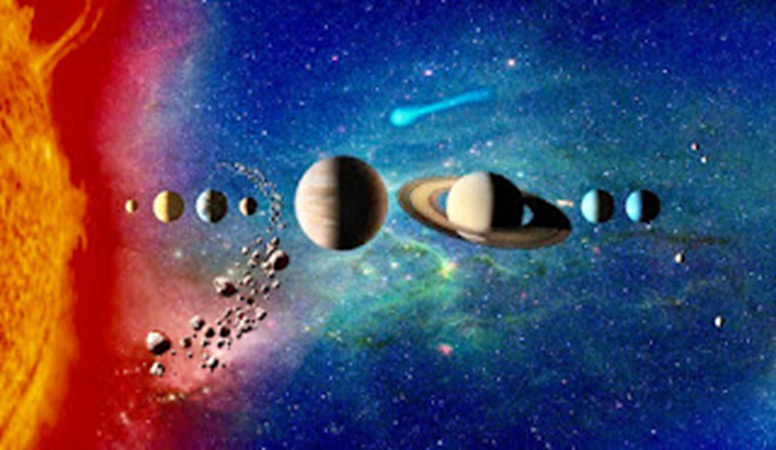
Space is very vast in a way that your imagination cannot imagine, and the solar system in which we live is considered a very small part of it, and no matter how much science discovers in that field, we still have a lot and a lot of work ahead of us to try to understand the secrets of some of its phenomena, which until this moment are considered mysterious And strange to our awareness of that, and in this article we decided to monitor the strangest space phenomena that were monitored without any scientific explanation for their occurrence.
Hurricanes appear on Jupiter like hives

Great Red Spot on Jupiter:
This is one of the strange phenomena that scientists have not been able to accurately explain to this day, as the SANA agency noticed the presence of a large and moving red spot on Jupiter, and scientists believe that it is one of the huge storms that are 400 years old.
It is scientifically known that hurricanes are found on most planets that have an atmosphere and moisture below their clouds, including the planet Earth, of course, where hurricanes come to some extent in a circular shape with an eye in its center, but they are completely different in giant gas planets, where a phenomenon was discovered Strange about hurricanes on Jupiter recently, which are often found to take hexagonal shapes that resemble a beehive around the poles of that planet, and this discovery is not limited to Jupiter only, but in 1988 scientists discovered a giant hexagonal hurricane on one of the poles of Saturn, but the hive-like pattern Bees on Jupiter were considered unique, and many theories were proposed about the causes of these strange hexagonal hurricanes, but they remain just speculations without a confirmed explanation.
The appearance of Saturn's moon Iapetus in the form of a nut
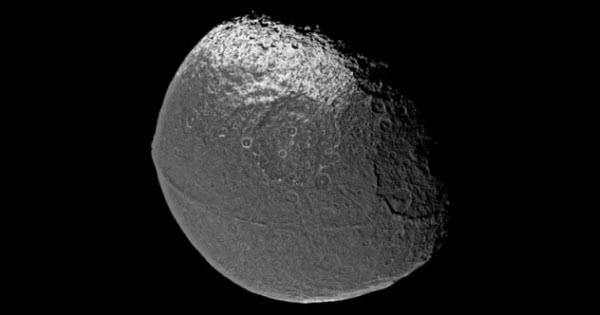
The moon “Iapetus” is the third largest moon of the planet “Saturn” in terms of size, and it occupies the eleventh place in the order of the moons of the solar system. 20 kilometers along its equator, which is more than double the height of Mount Everest, where these mountain ranges are responsible for its distinct and confusing shape, which takes a nut. Scientists are still not sure of the reason for the existence of these mountains in that way, but that Some of them believe that it may have formed from the remnants of a ring similar to Saturn's rings, and it eventually fell to its surface, and another team believes that it may be made of the debris of a former moon. Its strangeness is not limited to its shape, but also to its half-dark and half-light color, which may make it one of the strangest objects in our solar system.
Miranda's distorted moon on the planet Uranus
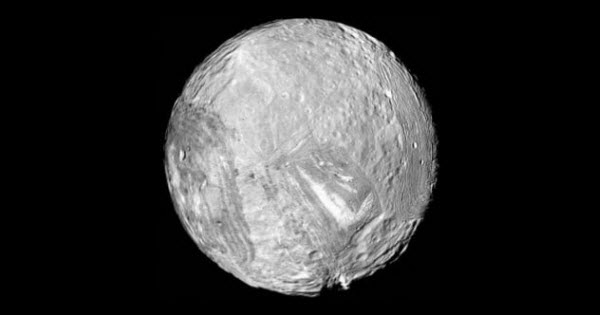
And it is one of the strangest moons in the solar system that revolves around the planet “Uranus” because it contains a very bumpy surface because it is full of holes and deep valleys in a way that gives it an appearance as if it were patchwork. Some even liken it to the monster created by the world “Frankenstein”, where there are some theories about the reasons for the deformation of that moon, one of which is that “Miranda” may have suffered from a series of catastrophic effects such as earthquakes and volcanoes or collisions from the rest of the celestial bodies such as meteors and meteorites and left devastating in that way, especially since the planet “Uranus” is likely to have encountered space phenomena represented in many collisions, which led to its lateral orbit, so this theory seems appropriate in terms of form, and there is another theory that the gravitational force of Uranus caused unusual volcanic activity for Miranda It caused him to reach that bumpy shape.
Neptune radiates more heat than it gets

It is logical that if a planet is far enough from the sun, then it will certainly be very cold. If we look at the planet “Pluto”, which was once the farthest planet in the solar system, then the warmest spot in it is equivalent to -223 degrees Celsius, and scientists believe that that planet was once It has rivers of liquid nitrogen crossing its surface, and after expelling “Pluto” from the planet of the solar system, “Neptune” officially became the farthest planet from the sun, which has a temperature of -200 degrees Celsius. Despite that degree, scientists do not believe that Neptune is as cold as it should be. This is because it somehow radiates more heat than twice the amount of energy it gets from the sun Until this moment, astronomers are still not sure of the reason, and perhaps the most logical theory to explain this phenomenon is that it is due to the rain of diamonds on its surface, as the theory says that the atmospheric pressure of Neptune causes the methane in its atmosphere to compress and turn it into diamonds, which fall Producing that heat as a result of friction with the heavy atmosphere, and this in turn explains the extraordinary amount of energy emitted from this giant, extremely cold planet.
Pluto has huge amounts of nitrogen
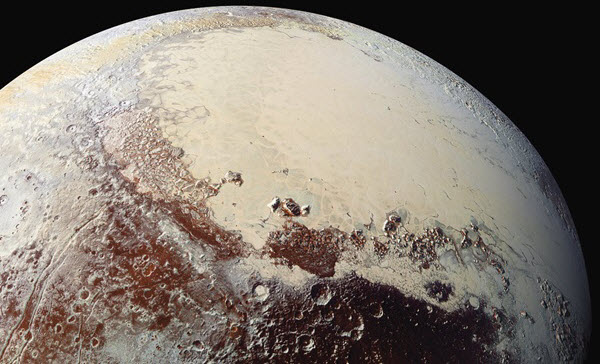
As a result of the small size of the planet “Pluto”, it hardly possesses the gravity necessary to coherence with its atmosphere, so it constantly loses hundreds of tons of its basic nitrogen atmosphere during its orbit around the sun, which leads some to wonder why Pluto’s nitrogen reserves have not run out so far, which is something Scientists think about it, as it is considered their best guess to explain this phenomenon is that there is some kind of hidden geological process inside the planet responsible for the formation of all the nitrogen reserves, but the exact nature of that process remains a mystery until now, and one of the planet’s space phenomena has no explanation.
There may be a ninth planet at the edge of the solar system

Despite the exclusion of the planet “Pluto” from the planets of the solar system, there are expectations among some astronomers of the existence of a ninth planet in the solar system as a result of their observation of some individual gravitational patterns in the objects located within the “Kuiper Belt”, which is an orbital field filled with large asteroids outside the orbit of a planet. Neptune, "where the existence of cases of gravitational anomalies explains the existence of a large planet that will one day be the "ninth planet", but at the present time it will be difficult to obtain tangible evidence of the existence of that planet because it will be in the outer regions of the solar system in a way that makes it difficult even for The most advanced telescopes have determined its location, and astronomers have estimated that this planet, if it existed, would be icy and almost three times the size of Earth.
methane on Mars

Despite the presence of methane on many planets, astronomers feel great enthusiasm whenever they find it on any rocky planet, as strange space phenomena on its surface, given that it is a common by-product of life, and it may be evidence of the presence of living organisms on those planets, as small amounts of methane were discovered That gas is on the surface of Mars, and scientists are likely to form it as a result of the changing seasons on the surface of the planet, and through the absorption of the rocks of that planet for it in one of the seasons in particular. Bacteria that live beneath the surface of that planet
. The presence of the tallest mountain in the solar system on Mars:
Scientists have discovered the existence of a very high mountain on Mars, with a height of 22 kilometers, three times longer than Mount Everest, and its base area is equal to the size of the state of Arizona in the United States of America, and this mountain is also considered one of the phenomena of Mars, which scientists were unable to explain.
The sky is raining minerals over Venus, Saturn, Neptune and Jupiter:

Where the rain there is unbelievably hot, refreshing sulfuric acid, the atmosphere of Venus is teeming with clouds containing sulfuric acid. But because the planet's surface is about 894 degrees Fahrenheit (480 degrees Celsius), rain only reaches 15.5 miles (25 kilometers) above the surface before it turns into gas.
According to the results, diamond rain falls on Saturn, Neptune, and Jupiter, among other planets, but Saturn may have the best conditions for this to happen. Saturn's intense lightning storms (10 strikes per second) can smash methane molecules in the atmosphere, causing carbon atoms to float freely in the air and begin to fall to the ground. As it travels through the dense layers of Saturn's atmosphere, it turns into graphite, eventually compressing into small diamond pieces.
The presence of snow on the planet Mercury:

Mercury is considered one of the closest planets to the sun, so it is one of the hottest and hottest planets, as the temperature on its surface reaches 427 degrees Celsius. Despite this high temperature, the NASA space agency discovered that Mercury carries approximately 100 billion tons of water ice, and this is considered one The most complex phenomena that scientists have been unable to explain.
The sun's upper atmosphere is much hotter than its surface

The surface of the sun is very hot, and it is the part that blinds you when you look directly at it, and although the temperature of that surface is 5500 degrees Celsius, the less visible atmosphere above the surface, known as the corona, is several times hotter, as its temperature ranges between 1 to 10 million degrees Celsius. It is also so faint that you can only see it during an eclipse. So why is it much hotter in the corona than in the bright surface of the Sun? Scientists are not sure, and they have only some theories, one of which says that it may be caused by millions of very small nano-sized solar flares that float on the surface of the sun every second, which leads to the transfer of energy from the surface to the atmosphere above.
The solar system itself is strange
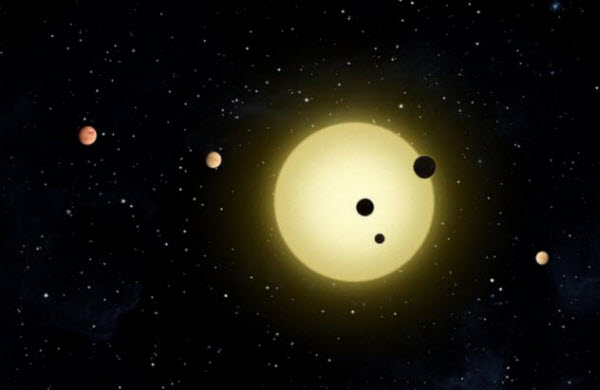
It may be that our solar system itself is characterized by strangeness, as NASA scientists found mysterious space phenomena represented in the fact that other star systems usually have planets of similar size and move in their orbits on a regular basis, which is the opposite of our solar system, whose planets are considered different in size, only Compare the largest and smallest of our planets, we will find that the diameter of Jupiter is 28 times the diameter of the planet Mercury, and Jupiter is equivalent in terms of volume to 24 thousand of Mercury, in addition to that the spacing between the planets does not appear regularly, which is confusing for astronomers, as some of them speculate that the gravity of the planet Jupiter and Saturn may be the reason for this.
Source: websites

